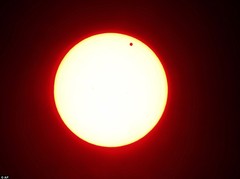Apostolos (Tolis) Christou, an astronomer at the Armagh Observatory, successfully observed the recent transit of Venus from the town of Lavrion, about 30 kilometres south–east of Athens. The next opportunity to observe this rare phenomenon will not occur until 2117.
Historically, observations of transits of Venus were used to calculate the distance from the Earth to the Sun – the Astronomical Unit (AU) – by triangulation, thereby obtaining the dimensions of the Solar System. The AU is the fundamental yardstick used for measuring the size of the Universe.
Nowadays, astronomers use accurate observations of the same phenomenon, that is the transit of an extra–solar planet (exoplanet) in front of a distant star, to infer the size and distance of such planets orbiting other stars. The technique depends on very precise measurements of the decrease in light of the distant star when the planet passes exactly between the Earth and the star.
In October 1995, Michel Mayor and Didier Queloz of the University of Geneva observed what is believed to have been the first confirmed exoplanet orbiting a sun-like star, 51 Pegasi. Currently, there are now almost 800 confirmed exoplanets – including a few then-unconfirmed cases from the 1980s. By February of this year, the Kepler spacecraft had discovered over 2,300 unconfirmed candidate planets orbiting almost 1,800 host stars.
Armagh Observatory is presently running a Transit of Venus Exhibition, from 10am – 11am and 3pm – 4pm during week-days, until Tuesday 12th June where some images of the June 2012 transit are on show. Please book your place by telephoning John McFarland on 028-3752-2928 or emailing jmf arm.ac.uk.
arm.ac.uk.
FOR FURTHER INFORMATION CONTACT: John McFarland at the Armagh Observatory, College Hill, Armagh, BT61 9DG. Tel.: 028-3752-2928; 028-3751-2962; Email: jmf arm.ac.uk
arm.ac.uk
















